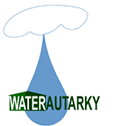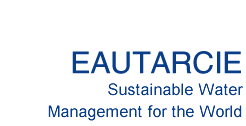
The EAUTARCIE concept is one of the possible forms of ecological sanitation, with a distinct feature: instead of doing an inventory of the problems, it rather goes to the source of these problems and proposes efficient, simple and inexpensive solutions. Its other main feature is its holistic approach, which takes into account various environmental impact issues.
The considerations developed within these pages have not yet been field-tested. The technical proposals have been extrapolated from our experiments and experience on single-home set-ups. Pilot projects are needed to help determine proper sizing of the various system components. Such experiments have, up to now, not been authorized in Belgium.
To see examples of EAUTARCIE homes that are self-sufficient and self-contained in terms of water consumption, click here.
To visualize the general schematic of a PLUVALOR system, click here![]() .
.
The text within this page was first published in French on www.eautarcie.com: in 2005
The original text has since been adapted and first published in English on this page at www.eautarcie.org: 2009-06-15
Last update : 2016-10-25


THE PLUVALOR System in an Urban Setting
Water Supply
Sustainable water management requires a coordinated use of all available sources of water. In cities where mains water is sometimes of dubious or even poor quality, other solutions can be implemented to provide the population with drinking water of high quality, at least for human consumption. Using rainwater is one option, although not the only one, provided we acknowledge the fact that the water recoverable from city roofs is not insignificant, even if it is too low to cover all household needs.
Need we repeat that in a polluted world where good-quality water is becoming scarce, you need to adapt water quality to its end-uses. We only need potable water for drink (water, coffee, tea, etc.) and food preparation. For non-food uses, we could use safe inoffensive water that is not « potable » in the legal sense, and of which the accidental absorption would not pose a health risk. This new vision on water quality provides a more pragmatic framework for water management, with substantial cost savings.
In order to relinquish the logic of water as a commodity, we deem that water services must be managed by urban municipalities, not by private corporations. Water supply must be considered as a service to the population, without any commercial interests. Tariffs for water must be determined within the context of coherent social and environmental policies. Moreover, taxation of water should cease. Taxing such a basic and vital need is morally questionable as it leads to such perversions as tagging rainwater harvesting as an « uncivic and antisocial practice ».
High-quality drinking water for the poor
The subject of water supply prompts growing concerns about the quality of tap water. Furthermore, the population is growingly reverting to bottled water instead of tap water. This costly solution also has a significant environmental impact. The alternative that is recommended on the EAUTARCIE website is the acquisition of a domestic reverse osmosis system. Nevertheless, beware of profiteering dealers specialized in domestic water conditioning systems. Read the chapter entitled « How to buy a Reverse Osmosis unit ».
Rainwater in cities – an environmental safeguard
Consider a city that is fully equipped with PLUVALOR Systems. The sum capacity of such a city's cisterns (capacity of 160 litres per m² of roof area) represents a storage capacity equivalent to a colossal stormwater basin. Stormwater runoff is controlled and stored instead of being fully discharged into a watercourse via sewers. It is then gradually released with household use. This is an important factor in regulating the soil moisture regime.
The Characteristics of an urban PLUVALOR System
When designing a new apartment building, the roof surface will ideally be separated in as many sectors as there are apartments [1]. Each sector will dispose of its own roof drain and cistern.
In spite of the potential economy of scale, we strongly advise against the installation of a common collective cistern to service many apartments. Water consumption greatly varies from one household to the next, which represents a source of conflict. When a collective cistern goes dry, the fault will always be attributed to the other cistern users.
The cistern's capacity (in litres) will be calculated by multiplying the roof catchment area (m²) by 160. For example, an apartment that is serviced by a 15 m² roof area will have a cistern of 15 x 160 = 2400 litres, or 2.4 m³.
This cistern will be placed in the basement or buried next to the building. Rainwater collected this way will be pumped by a small well-pump system located in a basement equipment room, with a 25- to 35-micron filter, after which comes a 10-micron filter. Small section pipes would then feed each apartment with safe « inoffensive » filtered rainwater, alongside the traditional mains water supply. The filtered rainwater pipe will be connected to a valve under the kitchen sink, to supply a reverse osmosis system that will provide good quality drinking water via a special tap in the kitchen sink. The other taps would deliver city water. Rainwater that is filtered and purified in this way is comparable to the best bottled mineral water on the market, at a cost of 2 to 3 Euro-cents per litre.
Thus one would use rainwater for food and drink (the water we swallow) while lesser-quality city water would be reserved for other household uses. In cities where mains city water becomes brackish due to grave water supply problems, city water could be regarded simply as safe inoffensive water to be reserved solely for non food needs (you should not even consider nano-filtration [2] as a option.) In such cases, subsidies could be offered towards the installation of individual rainwater filtration set-ups.
Nano-filtration is a technique used to transform badly polluted water into potable water, usually by the means of salt. The cost of such treated water is about 10 € per m³ (2003). To use such expensive water for toilet flushes is totally unreasonable.
False Objections
I often hear assertions that rainwater harvesting is not really useful within cities because of greater city air pollution and reduced available roof area per inhabitant.
City pollution
In reality, pollution of rainfall depends mainly on the wind regime. Heavily polluted rainfall can occur in areas that have no local industrial or urban pollution. Rainwater quality in cities is not fundamentally worse that elsewhere. In regions close to dust-generating industries, neighbouring domestic rainwater catchment systems tend to accumulate more sludge in their cisterns, which tends to clog the filters more quickly.
In large cities, winter rain and winter snow may have a slightly higher hydrocarbon content due to smoke from oil heating. The water that falls on roofs is also usually more acidic. The presence of sulphur dioxide (SO2) in smoke is conducive to dissolution of zinc (roofs and gutters) into the collected rainwater. This phenomenon is often overplayed by scientists who are directly or indirectly related to the water industry. It is easy to scare the population by raising the spectre of « heavy metals » or « bacteria » in rainwater. This unfortunately delays the onset of a coordinated management of water resources. Thus, the monopoly of drinking water as a commercial commodity is upheld. Such reports do not stand up to an objective scientific analysis. Fortunately, in water tanks, we have so far never measured zinc concentrations that exceed the standards for drinking water. And even if that were eventually the case, the reverse osmosis system that provides drinking water not only removes zinc, but all other undesirable elements, be it from rainwater or mains water.
Reduced available roof area
It is true that the required 30 m² of roof area per capita [3] for whole house rainwater reuse (excluding flush toilets) is rarely attained in cities. However, rainfall captured on city roofs remains a precious and important resource.
This value is based on an annual rainfall of about 800 to 900 mm. Even when rainwater is used as a water supply for apartments, it is more rational to supply flush toilets with city water, even if it is sometimes hard water.
In fact, a person's daily drinking water requirements![]() rarely exceed 3 to 5 litres. To harvest this quantity, a roof area of 2 to 3 m² is sufficient, with a storage capacity of 300 to 400 litres.
rarely exceed 3 to 5 litres. To harvest this quantity, a roof area of 2 to 3 m² is sufficient, with a storage capacity of 300 to 400 litres.
Thus, if an apartment's roof doesn't exceed 3 m2 per person, rainwater is reserved for food and drink. When the roof area is greater, you can go even further in rainwater reuse to obtain water that is naturally mild, for personal hygiene and laundry. This means connecting the hot-water tank, clothes washing machine and even the dishwasher to the rainwater feed, while maintaining the city connection as back-up in case of dry spells.
To continue reading, go to chapter on the SAINECO system in an urban setting.




